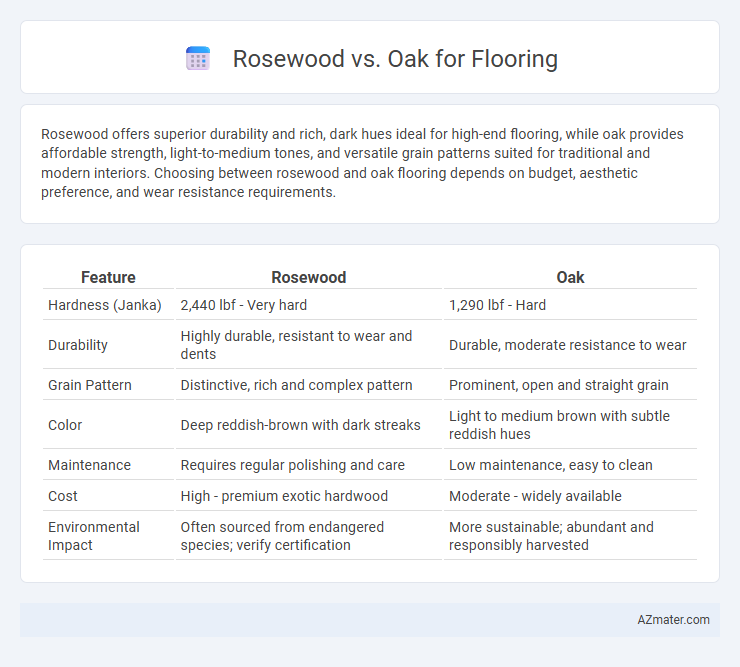Rosewood offers superior durability and rich, dark hues ideal for high-end flooring, while oak provides affordable strength, light-to-medium tones, and versatile grain patterns suited for traditional and modern interiors. Choosing between rosewood and oak flooring depends on budget, aesthetic preference, and wear resistance requirements.
Table of Comparison
| Feature | Rosewood | Oak |
|---|---|---|
| Hardness (Janka) | 2,440 lbf - Very hard | 1,290 lbf - Hard |
| Durability | Highly durable, resistant to wear and dents | Durable, moderate resistance to wear |
| Grain Pattern | Distinctive, rich and complex pattern | Prominent, open and straight grain |
| Color | Deep reddish-brown with dark streaks | Light to medium brown with subtle reddish hues |
| Maintenance | Requires regular polishing and care | Low maintenance, easy to clean |
| Cost | High - premium exotic hardwood | Moderate - widely available |
| Environmental Impact | Often sourced from endangered species; verify certification | More sustainable; abundant and responsibly harvested |
Introduction to Rosewood and Oak Flooring
Rosewood flooring offers a rich, luxurious appearance with deep reddish-brown hues and prominent grain patterns, known for its durability and natural resistance to wear and insect damage. Oak flooring, available in red and white varieties, is prized for its strength, versatility, and classic grain texture, making it one of the most popular hardwoods for residential and commercial spaces. Both woods provide excellent durability, but rosewood tends to be denser and more expensive, while oak offers a wide range of finishes and a timeless aesthetic.
Key Characteristics of Rosewood Flooring
Rosewood flooring is renowned for its rich, deep hues ranging from reddish-brown to dark purple, offering a luxurious and exotic appearance. Its dense grain structure provides exceptional durability and resistance to wear, making it suitable for high-traffic areas. The natural oils in rosewood enhance its resistance to moisture and pests, increasing longevity compared to many other hardwood options.
Key Characteristics of Oak Flooring
Oak flooring is renowned for its exceptional durability and striking grain patterns, making it a popular choice for both traditional and modern interiors. It offers excellent resistance to wear and scratches, supported by its hard, dense structure, which ensures long-lasting performance in high-traffic areas. The wood's natural color ranges from light tan to deeper reddish-brown hues, providing versatile options that complement various design aesthetics.
Aesthetic Differences: Color and Grain Patterns
Rosewood flooring features rich, deep reddish-brown hues with striking dark streaks, offering a dramatic and luxurious aesthetic, while oak flooring presents lighter tones ranging from pale beige to warm amber, creating a classic and inviting atmosphere. The grain pattern of rosewood is typically more pronounced and swirling, providing a bold, exotic appearance, whereas oak has a straighter, more uniform grain that emphasizes traditional elegance and versatility. Choosing between rosewood and oak depends on whether a bold, opulent look or a timeless, adaptable style is preferred for the interior design.
Durability and Hardness Comparison
Rosewood flooring offers exceptional durability with a Janka hardness rating between 2200 and 2870, making it highly resistant to dents and scratches. Oak, with a Janka hardness rating around 1290 to 1360 depending on the species, provides good durability but is noticeably softer compared to rosewood. The superior hardness of rosewood ensures longer-lasting floors in high-traffic areas, while oak remains a popular choice for its balance of strength and affordability.
Maintenance and Care Requirements
Rosewood flooring demands regular sealing and careful cleaning with pH-neutral products to maintain its rich color and prevent moisture damage, while oak flooring is more forgiving, requiring routine sweeping and occasional polishing to resist wear and scratches. Rosewood's natural oils help resist stains, but improper maintenance can lead to fading or warping, whereas oak's dense grain structure offers greater resilience against dents and daily wear. Both hardwoods benefit from humidity control to prevent expansion, but oak's lower maintenance needs make it a practical choice for high-traffic areas.
Cost Analysis: Rosewood vs Oak
Rosewood flooring typically costs between $8 to $15 per square foot, significantly higher than oak, which ranges from $3 to $12 per square foot, making oak a more budget-friendly option for large installations. Installation costs for both woods are similar, but the rarity and density of rosewood often require specialized tools and labor, increasing overall expenses. Long-term value favors rosewood due to its durability and unique grain patterns, which can enhance property value despite the initial higher investment.
Environmental Impact and Sustainability
Rosewood flooring often involves harvesting from slower-growing tropical trees, leading to higher environmental concerns and increased deforestation risks. Oak, a more abundant and faster-growing hardwood prevalent in temperate regions, presents a more sustainable option with better forest management practices supporting its use. Choosing oak over rosewood can significantly reduce ecological footprints while maintaining durability and aesthetic appeal in flooring applications.
Best Use Cases for Each Wood Type
Rosewood flooring offers rich, dark hues and high natural oil content, making it ideal for luxurious, high-traffic areas like living rooms and offices that benefit from its durability and resistance to moisture. Oak flooring, with its lighter tone and prominent grain, excels in versatility and durability, making it suitable for kitchens, hallways, and family rooms that require easy maintenance and a classic aesthetic. Both hardwood types provide lasting value, but rosewood suits elegant, formal spaces while oak adapts well to both traditional and contemporary interiors.
Conclusion: Choosing Between Rosewood and Oak Flooring
Rosewood flooring offers a rich, dark hue with exceptional hardness and natural resistance to wear, ideal for high-traffic areas seeking a luxurious aesthetic. Oak flooring provides a classic, lighter tone with strong durability and better affordability, making it a versatile choice for various interior styles. Selecting between rosewood and oak depends on budget, desired color palette, and long-term maintenance preferences to achieve the perfect flooring solution.

Infographic: Rosewood vs Oak for Flooring
 azmater.com
azmater.com